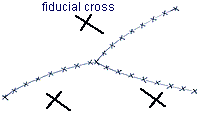8th step
: 01 : : 02
: : 03 : : 04 : : 05
: : 06 : : 07 : : 08
: : 09 : : 10 :
Measurements and Data Processing

typical set of measure points on tracks (small crosses)

measuring bubble chamber film
The aim of the bubble chamber picture data processing system is to
produce well-measured values for the energy and momentum of each particle
produced in a collision.
The details are very complicated technically, so here we will limit
ourselves to listing some of the key ideas:
-
By means of a computer controlled device, the coordinates of vertices and points on tracks are measured on three views and stored.
-
Using the accurately-known positions of 'fiducial' crosses scratched onto the bubble chamber windows, the measured coordinates are used to calculate the curves along which the particles have travelled.
-
Having made corrections to allow for the fact that the particles are slowing down, the curves are used to calculate the momenta of the particles as they leave the collision point. (Due to measurement errors, or due to the fact that neutral particles may have escaped, it is not always possible to do this in a unique way.)
-
For our event the following unique assignments was possible:
| px(MeV/c) | py(MeV/c) | pz(MeV/c) | E0(MeV/c2) | ||
| 8213.4 | -248.3 | 15.2 | 8232.0 | initial state | |
| 0.0 | 0.0 | 0.0 | 938.3 | ||
| 1481.8 | 27.8 | 224.0 | 1578.1 | final state | |
| 149.7 | -11.3 | 38.8 | 208.6 | ||
| 37.9 | -122.2 | -22.7 | 190.7 | ||
| 1508.6 | 128.5 | -70.5 | 1782.6 | ||
| 3545.6 | -162.9 | -245.0 | 3592.4 |
A brief inspection of these figures shows that there is less energy and momentum in the final state, showing that at least one neutral particle has escaped.
The purpose of the data processing is to provide as full a record as possible of all the interactions found in an experiment - which typically might have tens or even hundreds of thousands of interactions.
These are then analyzed by programs written by physicists to compare the results of the experiment with current theoretical ideas.